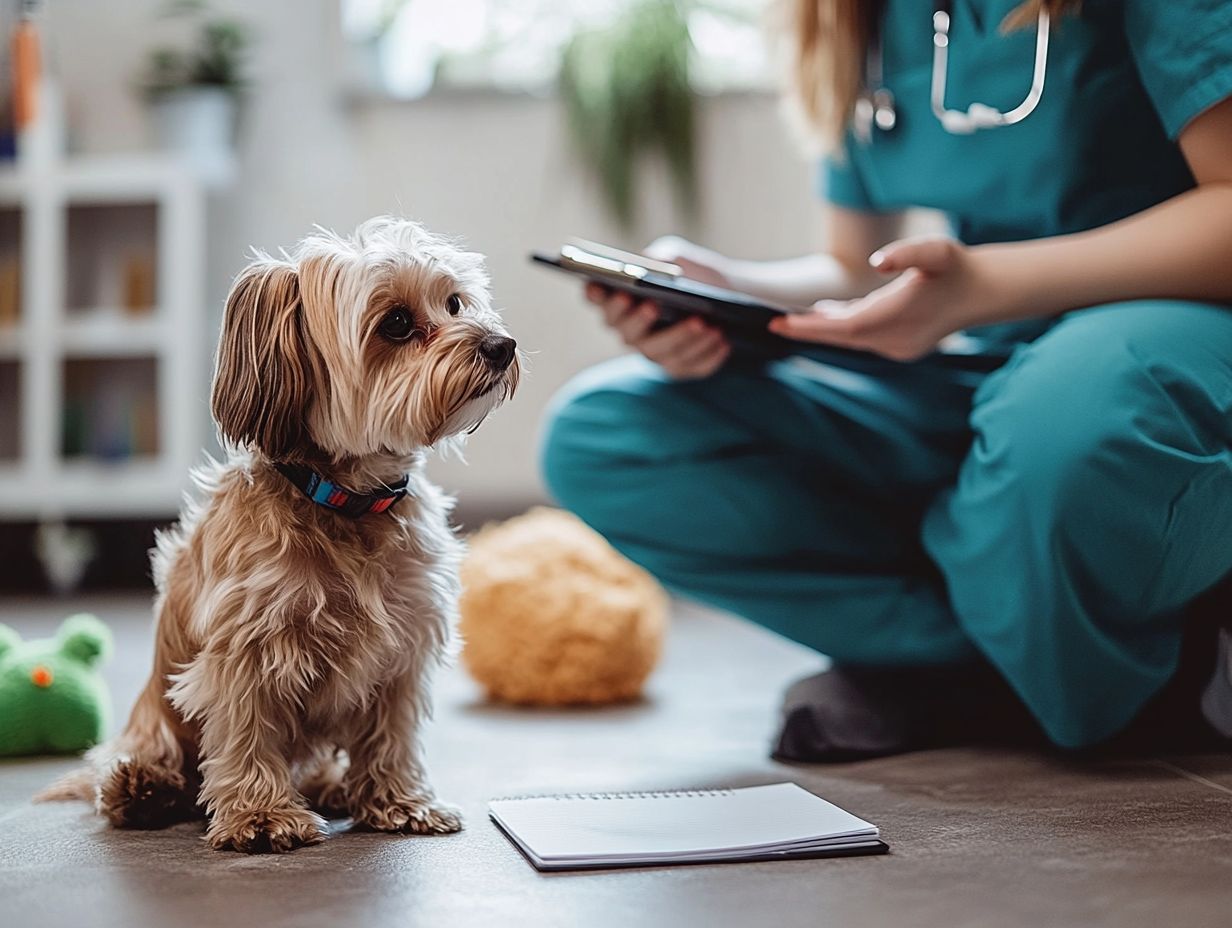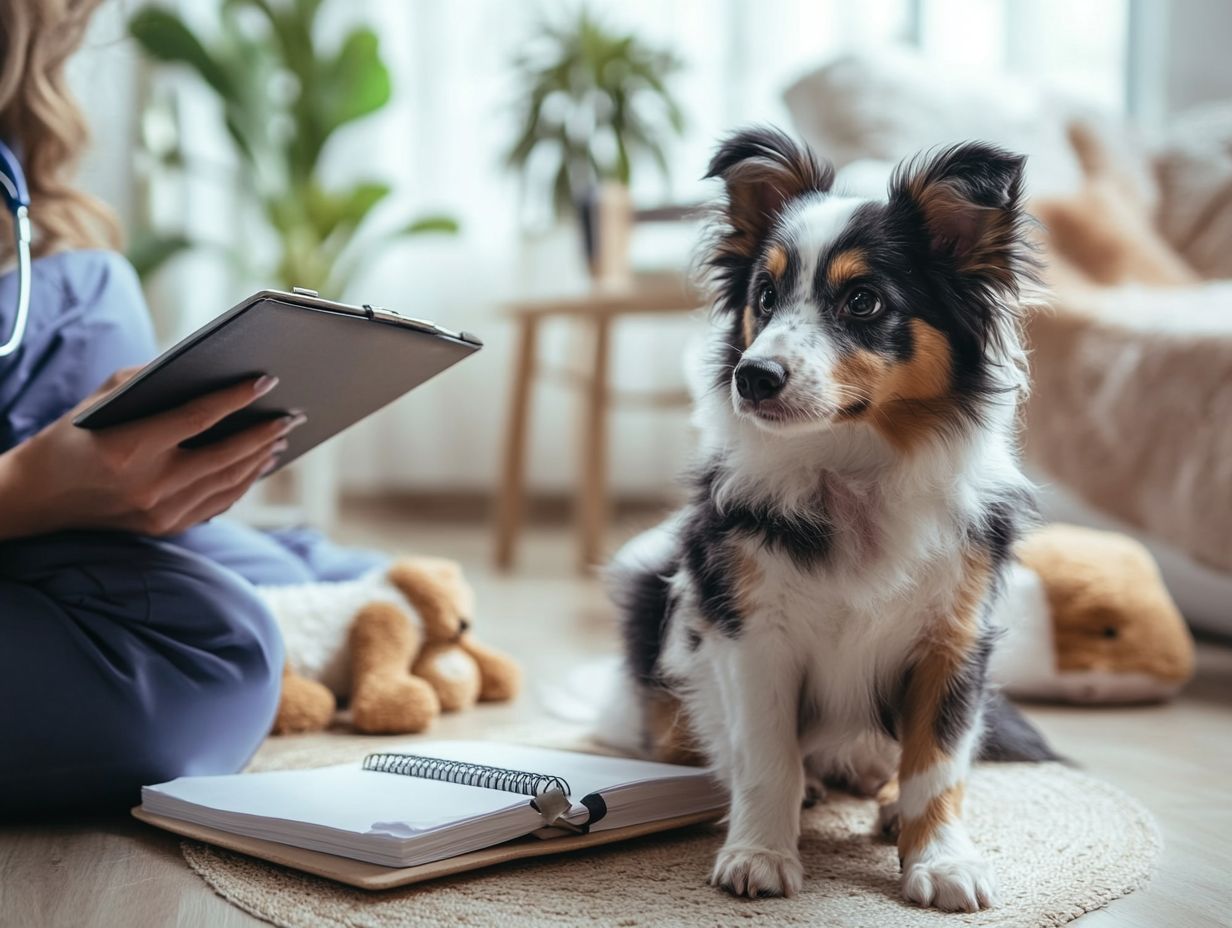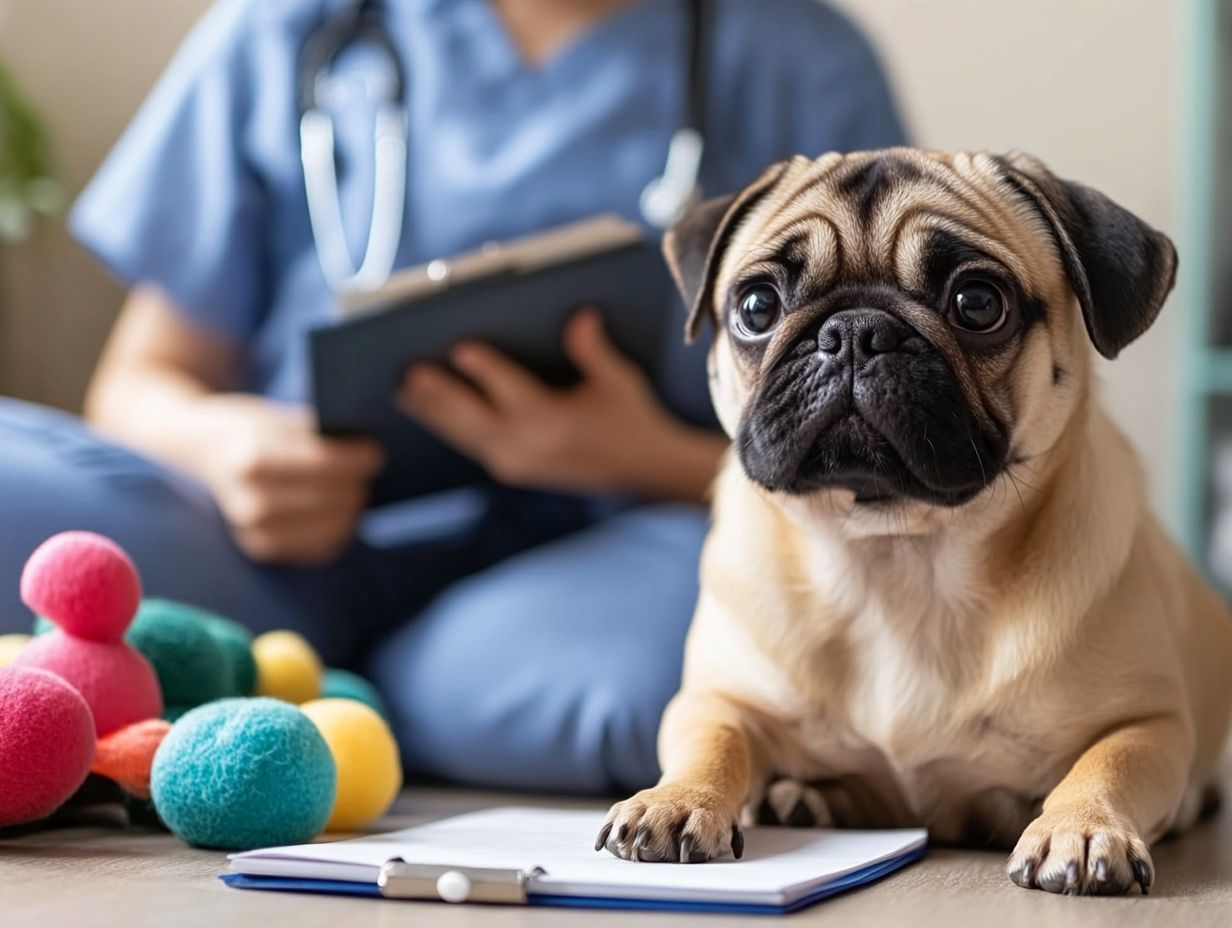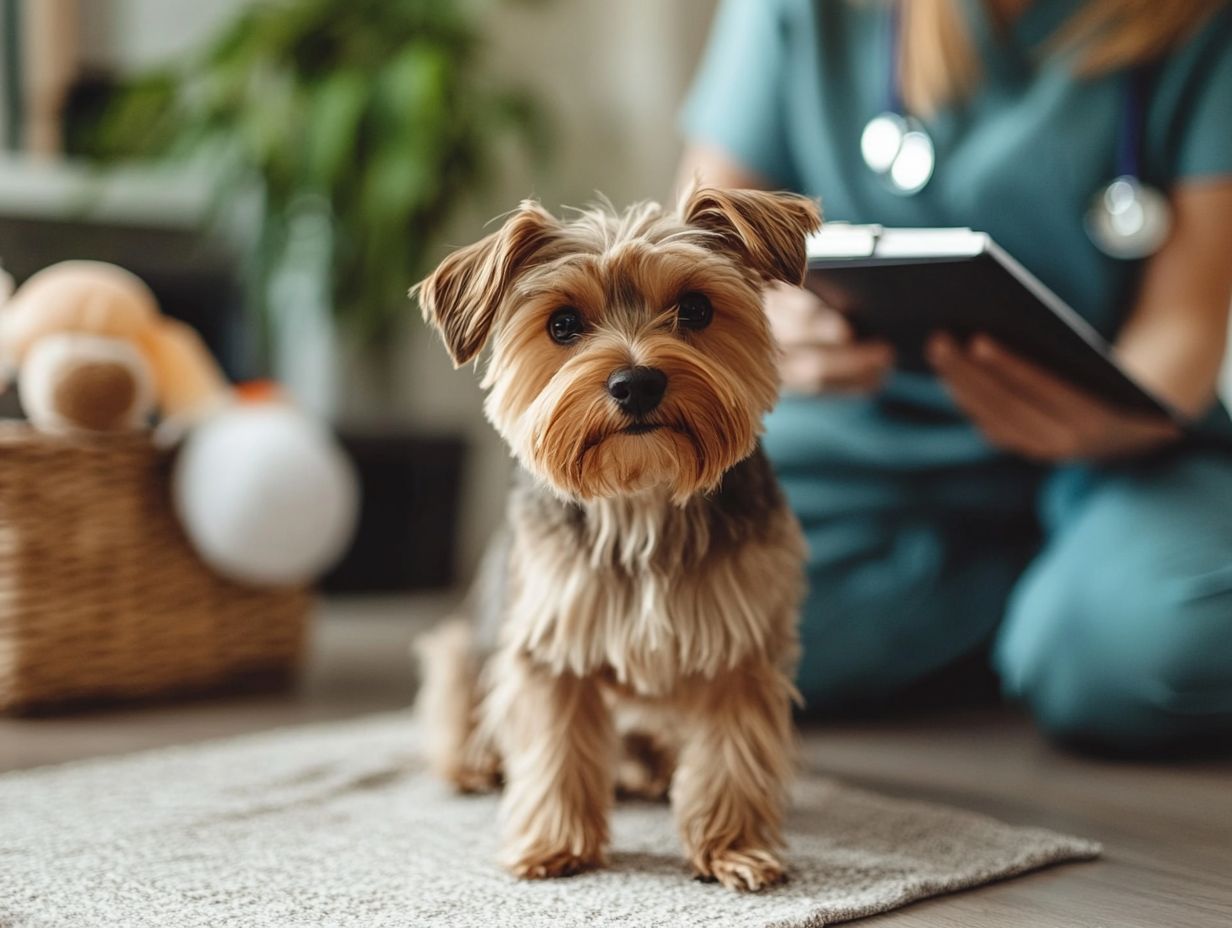How Often Should I Reassess My Pet’s Anxiety?
Understanding your pet s anxiety is essential for their overall well-being and happiness. Just like us, pets can experience anxiety for many reasons, and recognizing the causes and symptoms is the first step toward offering them the relief they need.
As your pet s environment and circumstances evolve, it becomes vital to regularly reassess their anxiety levels. This article delves into the significance of monitoring your pet’s behavior, identifying signs of shifting anxiety levels, and exploring effective reassessment methods. By doing so, you can ensure that your furry friend remains comfortable and content.
Contents
Key Takeaways:

- Regular reassessment of your pet’s anxiety is important for monitoring changes and ensuring their well-being.
- Look out for behavioral changes and consider environmental and lifestyle factors when reassessing your pet’s anxiety.
- Consult with a veterinarian and create a reassessment schedule to determine how often to check in and when to seek professional help.
Understanding Pet Anxiety
Understanding pet anxiety is essential for you as a pet owner who wants to create a healthy and supportive environment for your dog. Anxiety in pets, especially dogs, can show itself in many ways, such as excessive barking, destructive behavior, and even aggression.
By recognizing the signs of anxiety disorders, like fear-related anxiety and separation anxiety which happens when your pet feels stressed when left alone you can take proactive steps to manage and alleviate your dog’s anxiety symptoms. Cognitive dysfunction syndrome, or mental decline, can also contribute to anxiety in older dogs, underscoring the importance of understanding these behaviors for your pet’s well-being.
Causes and Symptoms of Anxiety in Pets
The causes of anxiety in pets can be quite complex, ranging from genetic tendencies to environmental stressors that create challenging situations for your dog. You might notice common symptoms like destructive behavior, excessive barking, or signs of distress during thunderstorms or when left alone often these are indicators of separation anxiety.
Genetics can significantly influence your pet’s anxiety levels, as certain breeds are naturally more predisposed to these issues. Past traumatic experiences, like a rough start in life or abandonment, can deepen these feelings.
Environmental factors, such as changes in routine, moving to a new home, or loud noises, often intensify anxiety symptoms. You may observe your furry friend displaying signs of distress pacing, whining, or hiding especially during separation or when faced with unfamiliar situations.
Understanding these intricate layers is crucial for you to develop effective management strategies and provide comfort to your anxious pet.
Importance of Reassessing Pet Anxiety
Regularly checking your pet’s anxiety levels keeps them happy and healthy! A dog’s behavior can change over time due to variations in their environment, health, and experiences.
By conducting regular evaluations, you can pinpoint any shifts in anxiety symptoms, enabling timely interventions that might involve behavioral training or adjustments in treatment methods.
This proactive approach is essential for enhancing your dog’s overall well-being, supporting positive reinforcement strategies, and fostering responsible pet parenting. Don’t wait until it’s too late make a plan today!
Is Your Furry Friend Feeling Anxious? Let s Explore Why Regular Check-Ups Are Vital!
Regularly reviewing your dog’s anxiety is crucial. It helps spot any changes in their anxiety disorders and symptoms, ensuring that your treatment plans remain effective. If you notice concerning signs, refer to what to do if your pet’s anxiety worsens for guidance.
As your dog ages or their environment shifts, you might notice changes in their anxiety symptoms. This often calls for a check-up of their training and any medications they might be receiving, such as fluoxetine or clomipramine, which help with anxiety.
Declining health, loud noises, or a new household member can intensify anxiety or reveal new issues. This is why working with veterinarians is essential; they offer valuable insights and can recommend necessary adjustments to your treatment plans.
For instance, if a vet sees that your dog isn t responding well to their current medications, they might suggest alternative therapies or change the dosage. Making these changes can lead to greater comfort and stability for your anxious pet, enhancing their overall quality of life.
Signs that Your Pet’s Anxiety May Have Changed

Recognizing signs of changing anxiety in your pet is essential. Timely intervention leads to effective treatment. Behavioral changes can show up in various ways, like increased destructive behavior, excessive barking, or unfamiliar signs of aggression or withdrawal.
By spotting these changes early, you can adjust your training methods and reassess treatment options, ultimately providing better support for your canine companion.
Behavioral Changes to Watch For
Behavioral changes in dogs can appear in many ways. Increased destructive tendencies or subtle shifts in how they handle stress may indicate evolving anxiety symptoms.
As a pet owner, be vigilant about signs like scratching, inappropriate urination, or the emergence of separation anxiety. These behaviors may signify worsening anxiety or a need for a fresh assessment.
Understanding these changes is crucial for your dog s well-being. For example, unusual barking, pacing, or shifts in appetite can reflect their emotional state, highlighting situational stressors or deeper-rooted anxiety.
Consider the context behind these behaviors. Loud noises, new visitors, or changes in routine can impact your pet s mental health. By observing these behaviors alongside their environments, you can effectively communicate your concerns to a veterinarian or dog behaviorist.
This proactive approach enables tailored interventions to reduce anxiety and improve your dog’s quality of life.
Factors to Consider When Reassessing Pet Anxiety
When you reassess your dog’s anxiety, consider various factors that shape their emotional state and behavior. Environmental influences, like changes in your household or external stressors, can significantly affect your dog’s anxiety levels.
Lifestyle changes, whether due to new family dynamics or shifts in daily routines, may also require closer evaluation of anxiety treatments and preventive strategies.
Environmental and Lifestyle Factors
Environmental and lifestyle factors play a substantial role in the anxiety your dog may experience. These factors impact your dog’s overall behavior and emotional well-being.
Changes such as relocating to a new home, shifts in daily routines, or the addition of new pets can significantly elevate a dog s anxiety levels, necessitating a thoughtful approach to training and anxiety management.
Loud noises from nearby construction can also heighten their stress, as well as sudden changes in your household dynamic that can leave your dog feeling insecure or overwhelmed. Dogs thrive in stable environments.
By incorporating positive reinforcement techniques tailored to these specific situations, you can effectively adapt your training methods to promote a sense of security for your dog. Establishing a consistent routine and providing a safe space for them to retreat can greatly alleviate anxiety triggers.
Understanding these elements enables you to take a compassionate approach to managing your canine companion’s behavior.
Methods for Reassessing Pet Anxiety
Reassessing your pet’s anxiety requires a thoughtful blend of keen observation and expert consultation with a veterinarian to achieve the best outcomes for your dog. By closely monitoring behavior changes and collaborating with a veterinary professional, you can craft personalized anxiety prevention strategies and implement effective training methods that truly support your canine companion.
Observation and Consultation with a Veterinarian

Observation serves as a foundational method for reassessing your pet’s anxiety. It enables you to identify changes in behavior that might warrant a consultation with a veterinarian. Regular check-ins with your vet can unveil valuable insights into anxiety treatment options and training methods tailored to your dog’s unique needs.
By keeping track of daily habits, interactions, and specific triggers, you can enhance communication with veterinary professionals. This collaborative approach not only aids in customizing treatment plans but also deepens your understanding of your furry companion s emotional well-being.
When you notice changes such as excessive barking, withdrawal, or destructive behavior, it s crucial to seek veterinary advice without delay. Being proactive can significantly elevate your dog’s quality of life and equip you with the necessary tools to implement effective training methods designed to alleviate anxiety.
Creating a Reassessment Schedule
Creating a reassessment schedule is a great way to monitor your dog’s anxiety actively! Regular evaluations allow you to discuss any behavioral changes with your veterinarian and understand what to expect during a pet anxiety assessment, ensuring that you can make timely adjustments to both anxiety treatment and dog training methods as needed.
How Often to Reassess and When to Seek Help
Determining how often you should reassess your dog’s anxiety is essential for effective management and treatment. It’s wise to consider a reassessment every six months or sooner if you notice any significant behavioral changes. If you have concerns, such as what to do if your pet develops anxiety suddenly, don’t hesitate to reach out to your veterinarian when needed.
Understanding your dog s individual needs is crucial, as some may require more frequent check-ins depending on their unique circumstances. For example, if you ve recently moved or welcomed a new family member, these changes can trigger heightened anxiety levels.
Keep an eye out for signs that might indicate a need for a veterinary consultation, such as excessive barking, destructive behaviors, or shifts in appetite.
Remaining vigilant is vital; early intervention can significantly enhance treatment effectiveness, ultimately providing the support your furry friend needs for a better quality of life.
Frequently Asked Questions
How Often Should I Reassess My Pet’s Anxiety?
The frequency of reassessing your pet’s anxiety may vary depending on the severity of their condition and any changes in their environment or routine. It’s generally best to check in at least every 3 to 6 months or sooner if things change. For more detailed guidance, consider exploring how to monitor progress in pet anxiety management.
What are the Signs of Anxiety in Pets?

Common signs of anxiety in pets include excessive barking or meowing. Other signs are destructive behavior, changes in appetite, hiding, escaping attempts, and excessive grooming.
Can I Check My Pet’s Anxiety on My Own?
If you know your pet’s behavior and their anxiety triggers, you can monitor their progress. It’s best to consult a veterinarian for a complete checkup.
What if My Pet’s Anxiety Gets Worse?
If you notice worsening anxiety or new concerning behaviors, consult a professional immediately. They may need an updated treatment plan or more support.
Is a Check Necessary if My Pet’s Anxiety Has Improved?
Yes, even if your pet seems better, checking their anxiety is important. This helps ensure their current treatment is still working effectively.
Are There External Factors That May Affect My Pet’s Anxiety?
Yes, changes in routine, new household members, or medical issues can affect your pet’s anxiety. Regular checks are essential to provide your pet with the best care.






